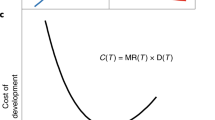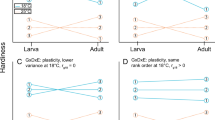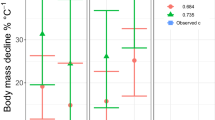Abstract
Climate warming is expected to increase the energy demands of ectotherms by accelerating their metabolic rates exponentially. However, this prediction ignores environmental complexity such as species interactions. Here, to better understand the metabolic costs of climate change for ectotherms, we reared three Drosophila species in either single-species or two-species cultures at different temperatures and projected adult metabolic responses under an intermediate climate-warming scenario across the global range of Drosophila. We determined that developmental acclimation to warmer temperatures can reduce the energetic cost of climate warming from 39% to ~16% on average by reducing the thermal sensitivity of metabolic rates. However, interspecific interactions among larvae can erode this benefit of developmental thermal acclimation by increasing the activity of adults that develop at warmer temperatures. Thus, by ignoring species interactions we risk underestimating the metabolic costs of warming by 3–16% on average.
This is a preview of subscription content, access via your institution
Access options
Access Nature and 54 other Nature Portfolio journals
Get Nature+, our best-value online-access subscription
$29.99 / 30 days
cancel any time
Subscribe to this journal
Receive 12 print issues and online access
$209.00 per year
only $17.42 per issue
Buy this article
- Purchase on Springer Link
- Instant access to full article PDF
Prices may be subject to local taxes which are calculated during checkout




Similar content being viewed by others
Data availability
Drosophila occurrence records were downloaded from https://www.gbif.org/ using the R package rgbif v.3.7.3 (GBIF Occurrence Download https://doi.org/10.15468/dl.8aymsf, accessed on 17 March 2022)45. Recent climate data (1970–2000) were downloaded from WorldClim v.2.1 (ref. 46) (https://worldclim.org/) using the R package raster v.3.6-3 (ref. 47). Projected future climate data (2081–2100) under the SSP 2-4.5 scenario (CMIP6) for eight global climate models (BCC-CSM2-MR, CanESM5, CNRM-CM6-1, CNRM-ESM2-1, IPSL-CM6A-LR, MIROC-ES2L, MIROC6 and MRI-ESM2-0) were downloaded manually from WorldClim v.2.1 (ref. 46). All other data generated and analysed during the current study are available in the Zenodo repository, https://doi.org/10.5281/zenodo.7475922 (ref. 48).
Code availability
R code used for data analysis is available in the Zenodo repository, https://doi.org/10.5281/zenodo.7475922 (ref. 48).
References
Gillooly, J. F., Brown, J. H., West, G. B., Savage, V. M. & Charnov, E. L. Effects of size and temperature on metabolic rate. Science 293, 2248–2251 (2001).
Seebacher, F., White, C. R. & Franklin, C. E. Physiological plasticity increases resilience of ectothermic animals to climate change. Nat. Clim. Change 5, 61–66 (2015).
Havird, J. C. et al. Distinguishing between active plasticity due to thermal acclimation and passive plasticity due to Q10 effects: why methodology matters. Funct. Ecol. 34, 1015–1028 (2020).
Dillon, M. E., Wang, G. & Huey, R. B. Global metabolic impacts of recent climate warming. Nature 467, 704–706 (2010).
White, C. R., Alton, L. A., Bywater, C. L., Lombardi, E. J. & Marshall, D. J. Metabolic scaling is the product of life history optimization. Science 377, 834–839 (2022).
Savage, V. M., Gilloly, J. F., Brown, J. H. & Charnov, E. L. Effects of body size and temperature on population growth. Am. Nat. 163, 429–441 (2004).
Bernhardt, J. R., Sunday, J. M. & O’Connor, M. I. Metabolic theory and the temperature–size rule explain the temperature dependence of population carrying capacity. Am. Nat. 192, 687–697 (2018).
Damuth, J. Population density and body size in mammals. Nature 290, 699–700 (1981).
Schuster, L., Cameron, H., White, C. R. & Marshall, D. J. Metabolism drives demography in an experimental field test. Proc. Natl Acad. Sci. USA 118, e2104942118 (2021).
Amarasekare, P. & Coutinho, R. M. The intrinsic growth rate as a predictor of population viability under climate warming. J. Anim. Ecol. 82, 1240–1253 (2013).
Amarasekare, P. & Savage, V. A framework for elucidating the temperature dependence of fitness. Am. Nat. 179, 178–191 (2012).
Lande, R. Risks of population extinction from demographic and environmental stochasticity and random catastrophes. Am. Nat. 142, 911–927 (1993).
Comeault, A. A. & Matute, D. R. Temperature-dependent competitive outcomes between the fruit flies Drosophila santomea and Drosophila yakuba. Am. Nat. 197, 312–323 (2021).
Davis, A. J., Jenkinson, L. S., Lawton, J. H., Shorrocks, B. & Wood, S. Making mistakes when predicting shifts in species range in response to global warming. Nature 391, 783–786 (1998).
Davis, A. J., Lawton, J. H., Shorrocks, B. & Jenkinson, L. S. Individualistic species responses invalidate simple physiological models of community dynamics under global environmental change. J. Anim. Ecol. 67, 600–612 (1998).
Gilman, S. E., Urban, M. C., Tewksbury, J., Gilchrist, G. W. & Holt, R. D. A framework for community interactions under climate change. Trends Ecol. Evol. 25, 325–331 (2010).
Janča, M. & Gvoždík, L. Costly neighbours: heterospecific competitive interactions increase metabolic rates in dominant species. Sci. Rep. 7, 5177 (2017).
Pettersen, A. K., Hall, M. D., White, C. R. & Marshall, D. J. Metabolic rate, context-dependent selection, and the competition–colonization trade-off. Evol. Lett. 4, 333–344 (2020).
DeLong, J. P., Hanley, T. C. & Vasseur, D. A. Competition and the density dependence of metabolic rates. J. Anim. Ecol. 83, 51–58 (2014).
Reid, D., Armstrong, J. D. & Metcalfe, N. B. Estimated standard metabolic rate interacts with territory quality and density to determine the growth rates of juvenile Atlantic salmon. Funct. Ecol. 25, 1360–1367 (2011).
Ayala, F. J. in Essays in Evolution and Genetics in Honor of Theodosius Dobzhansky (eds Hecht, M. K. & Steere, W. C.) 121–158 (Springer, 1970).
Atkinson, W. D. & Shorrocks, B. Aggregation of larval Diptera over discrete and ephemeral breeding sites: the implications for coexistence. Am. Nat. 124, 336–351 (1984).
McKenzie, J. A. & McKechnie, S. W. A comparative study of resource utilization in natural populations of Drosophila melanogaster and D. simulans. Oecologia 40, 299–309 (1979).
Alton, L. A. et al. Developmental nutrition modulates metabolic responses to projected climate change. Funct. Ecol. 34, 2488–2502 (2020).
Mitchell, K. A. & Hoffmann, A. A. Thermal ramping rate influences evolutionary potential and species differences for upper thermal limits in Drosophila. Funct. Ecol. 24, 694–700 (2010).
Overgaard, J., Kristensen, T. N., Mitchell, K. A. & Hoffmann, A. A. Thermal tolerance in widespread and tropical Drosophila species: does phenotypic plasticity increase with latitude? Am. Nat. 178, S80–S96 (2011).
Kellermann, V. et al. Comparing thermal performance curves across traits: how consistent are they? J. Exp. Biol. 222, jeb193433 (2019).
Terblanche, J. S., Clusella-Trullas, S. & Chown, S. L. Phenotypic plasticity of gas exchange pattern and water loss in Scarabaeus spretus (Coleoptera: Scarabaeidae): deconstructing the basis for metabolic rate variation. J. Exp. Biol. 213, 2940–2949 (2010).
Tewksbury, J. J., Huey, R. B. & Deutsch, C. A. Putting the heat on tropical animals. Science 320, 1296–1297 (2008).
Bos, M., Burnet, B., Farrow, R. & Woods, R. A. Mutual facilitation between larvae of the sibling species Drosophila melanogaster and D. simulans. Evolution 31, 824–828 (1977).
Arthur, W. On the complexity of a simple environment: competition, resource partitioning and facilitation in a two-species Drosophila system. Phil. Trans. R. Soc. B 313, 471–508 (1986).
Hodge, S., Mitchell, P. & Arthur, W. Factors affecting the occurrence of facilitative effects in interspecific interactions: an experiment using two species of Drosophila and Aspergillus niger. Oikos 87, 166–174 (1999).
Bath, E., Morimoto, J. & Wigby, S. The developmental environment modulates mating-induced aggression and fighting success in adult female Drosophila. Funct. Ecol. 32, 2542–2552 (2018).
Thibert, J., Farine, J. P., Cortot, J. & Ferveur, J. F. Drosophila food-associated pheromones: effect of experience, genotype and antibiotics on larval behavior. PLoS ONE 11, e0151451 (2016).
Chown, S. L. et al. Scaling of insect metabolic rate is inconsistent with the nutrient supply network model. Funct. Ecol. 21, 282–290 (2007).
Becker, R. A., Wilks, A. R. & Brownrigg, R. mapdata: extra map databases. R version 2.3.0 https://CRAN.R-project.org/package=mapdata (2018).
R Core Team R: A Language and Environment for Statistical Computing (R Foundation for Statistical Computing, 2022).
Brooks, M. E. et al. glmmTMB balances speed and flexibility among packages for zero-inflated generalized linear mixed modeling. R J. 9, 378–400 (2017).
Bates, D., Mächler, M., Bolker, B. & Walker, S. Fitting linear mixed-effects models using lme4. J. Stat. Softw. 67, 1–48 (2015).
Bolker, B. & R Development Core Team bbmle: tools for general maximum likelihood estimation. R version 1.0.25 https://CRAN.R-project.org/package=bbmle (2022).
Kuznetsova, A., Brockhoff, P. B. & Christensen, R. H. B. lmerTest package: tests in linear mixed effects models. J. Stat. Softw. 82, 1–26 (2017).
Fox, J. & Weisberg, S. An R Companion to Applied Regression 3rd edn (Sage, 2019).
Hartig, F. DHARMa: residual diagnostics for hierarchical (multi-level/mixed) regression models. R version 0.4.6 https://CRAN.R-project.org/package=DHARMa (2022).
Messamah, B., Kellermann, V., Malte, H., Loeschcke, V. & Overgaard, J. Metabolic cold adaptation contributes little to the interspecific variation in metabolic rates of 65 species of Drosophilidae. J. Insect Physiol. 98, 309–316 (2017).
Chamberlain, S. et al. rgbif: interface to the global biodiversity information facility API. R version 3.7.3 https://CRAN.R-project.org/package=rgbif (2022).
Fick, S. E. & Hijmans, R. J. WorldClim 2: new 1‐km spatial resolution climate surfaces for global land areas. Int. J. Climatol. 37, 4302–4315 (2017).
Hijmans, R. J. raster: geographic data analysis and modeling. R version 3.6-3 https://CRAN.R-project.org/package=raster (2022).
Alton, L. A. & Kellermann, V. Data for “Interspecific interactions alter the metabolic costs of climate warming”. Zenodo https://doi.org/10.5281/zenodo.7475922 (2023).
White, C. R. et al. Geographical bias in physiological data limits predictions of global change impacts. Funct. Ecol. 35, 1572–1578 (2021).
Acknowledgements
C. White provided equipment and R code49, C. Sgrò provided access to fly stocks, T. Thomason assisted with fly maintenance and data collection and C. Bywater assisted with data extraction. L.A.A. and V.K. were funded by a Monash University Faculty of Science Advancing Women’s Success Grant (L.A.A. and V.K.) and the Australian Research Council (DE14100141 (V.K.), DP180103925 (L.A.A.), FT200100703 (V.K.) and DP220103421 (L.A.A.)).
Author information
Authors and Affiliations
Contributions
L.A.A. and V.K. conceived and designed the study, performed the experiments, analysed the data and wrote the paper. L.A.A. performed the modelling.
Corresponding author
Ethics declarations
Competing interests
The authors declare no competing interests.
Peer review
Peer review information
Nature Climate Change thanks Paul Huxley, Tommy Norin, Mélanie Thierry, Mathieu Videlier and the other, anonymous, reviewer(s) for their contribution to the peer review of this work.
Additional information
Publisher’s note Springer Nature remains neutral with regard to jurisdictional claims in published maps and institutional affiliations.
Extended data
Extended Data Fig. 1 Conceptual diagram describing the thermal sensitivities of metabolic rate.
The thermal sensitivity of metabolic rate can be described by the factorial change in metabolic rate relative to a 10°C change in temperature (Q10). The metabolic rates of ectotherms acclimated to cold (blue line) and warm (red line) temperatures accelerate approximately exponentially with acute increases in temperature as described by the acute Q10. Acclimation to warmer temperatures causes a shift to the right in the reaction norm for metabolic rate. When measured at the same temperature, warm-acclimated ectotherms have lower metabolic rates than cold-acclimated ectotherms as described by the acclimation Q10. When cold- and warm- acclimated ectotherms are measured at their respective acclimation temperatures, the thermal sensitivity of metabolic rate can be described by the post-acclimation Q10. The post-acclimation Q10 therefore describes the sensitivity of metabolic rate to changes in temperature that last longer than several days and thus describes how acclimation to warmer temperatures opposes the acute thermodynamic effect of temperature on metabolic rate. The post-acclimation Q10 is therefore lower than the acute Q10.
Extended Data Fig. 2 Absolute metabolic cost of interspecific interactions under climate warming.
Spatially explicit predictions of the absolute metabolic cost (mW g-0.75) of interspecific interactions at the end of the century under an intermediate climate-warming scenario across the global range of Drosophila (n = 1,944,000). Changes in temperature (a) at each location were calculated between recent (1970–2000) and projected future (2081–2100) climates using the mean temperature of the warmest quarter at a 10 arcmin resolution. The warmest quarter is assumed to be when Drosophila are most active. Future temperatures were extracted from climate projections (CMIP Phase 6) based on eight global climate models (BCC-CSM2-MR, CanESM5, CNRM-CM6-1, CNRM-ESM2-1, IPSL-CM6A-LR, MIROC-ES2L, MIROC6 and MRI-ESM2-0) under the Shared Socio-Economic Pathway 2–4.5 scenario. Predictions are based on the thermal sensitivities of the routine metabolic rate (described by Q10 values) of Drosophila melanogaster (Mel) (b, c) and D. simulans (Sim) (d) (abbreviated name in bold) following developmental thermal acclimation in single-species or two-species cultures with a heterospecific (Heterosp.) (abbreviated name not in bold). For Mel, the heterospecific was either Sim or D. sulfurigaster (Sulf). For Sim, the heterospecific was Mel. Metabolic costs of interspecific interactions under climate warming are expressed as the absolute difference between predicted metabolic rates with and without interspecific interactions in units of mW g-0.75 (see Eq. 8 in Methods). Predictions are constrained to within 200 km of occurrence localities. Data are summarized for each region with boxes showing the interquartile range (IQR), lines within boxes showing the median, whiskers showing the 1.5×IQR range, and data points are the mean (Arctic: n = 304,560; north temperate: n = 559,440; tropics: n = 604,800; south temperate: 475,200). Outliers are excluded from box plots for visual clarity. Coastline data from mapdata v2.3.036.
Supplementary information
Supplementary Information
Supplementary Note, Tables 1–8 and Fig. 1.
Rights and permissions
Springer Nature or its licensor (e.g. a society or other partner) holds exclusive rights to this article under a publishing agreement with the author(s) or other rightsholder(s); author self-archiving of the accepted manuscript version of this article is solely governed by the terms of such publishing agreement and applicable law.
About this article
Cite this article
Alton, L.A., Kellermann, V. Interspecific interactions alter the metabolic costs of climate warming. Nat. Clim. Chang. 13, 382–388 (2023). https://doi.org/10.1038/s41558-023-01607-6
Received:
Accepted:
Published:
Issue Date:
DOI: https://doi.org/10.1038/s41558-023-01607-6
This article is cited by
-
Response to climate change can be altered by species competition
Nature Climate Change (2023)



